I’m excited to share my Mediterranean diet meal plan with you. It focuses on plant-based foods, healthy fats, and whole grains. This makes it a lifestyle, not just a diet. The plan is easy, with simple breakfasts and lunches, and occasional leftovers for dinner.
This meal plan helps you lose 1 to 2 pounds a week. It starts at 1,200 calories a day. You can adjust it to 1,500 or 2,000 calories for different needs.
Looking to improve your heart health or boost your brain? This Mediterranean diet meal plan is a great start. Let’s explore the key principles, benefits, and tasty recipes that will make you feel great.
Understanding a Mediterranean Diet: Core Principles and Benefits
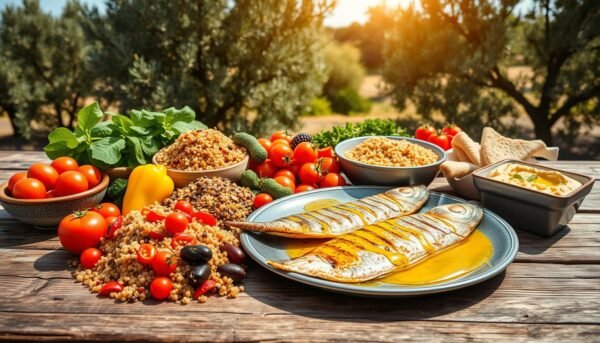
The Mediterranean diet focuses on eating whole, natural foods. It’s all about fruits, vegetables, whole grains, beans, lentils, nuts, and healthy fats. These foods help keep your heart, brain, and body healthy.
Health Benefits and Disease Prevention
Many studies prove the Mediterranean diet is great for your health. It lowers the risk of heart disease, diabetes, and some cancers. Eating nutrient-rich foods helps keep your blood pressure and sugar levels in check.
Key Nutritional Components
- Fruits and vegetables: Aim for 3 servings of each per day
- Whole grains and starchy vegetables: 3 to 6 servings daily
- Healthy fats like olive oil: 1 to 4 servings (1 tablespoon) per day
- Legumes: 3 servings per week (1/2 cup per serving)
- Fish: 3 servings per week (3-4 ounces per serving)
- Nuts: At least 3 servings per week (1/4 cup or 2 tablespoons of nut butter)
Scientific Evidence Supporting Mediterranean Eating
Research has shown the Mediterranean diet is very good for you. It’s ranked high by U.S. News and World Report. It’s great for your heart, brain, and body.
Essential Mediterranean Diet Shopping List
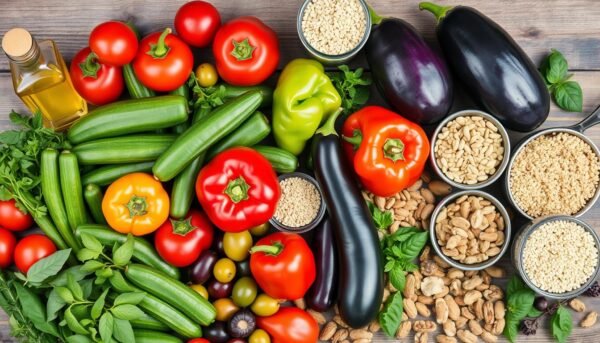
Adopting a Mediterranean diet starts with a good grocery list. Focus on fresh, whole foods. Think lots of fresh produce, seafood, whole grains, and legumes.
Begin with key items: extra virgin olive oil as your main fat; a variety of fish; beans, lentils, and legumes; whole grains like oatmeal and quinoa; nuts and seeds; eggs; and fermented dairy like yogurt and cheese.
Shop the store’s edges for fresh items. But don’t skip the middle aisles for canned beans, frozen produce, and whole grains. Fill your cart with leafy greens, fruits (like citrus, berries, figs, and avocados), seafood (salmon, sardines, tuna), poultry, and healthy fats.
| Food Category | Mediterranean Diet Essentials |
|---|---|
| Oils and Fats | Extra virgin olive oil, avocado oil |
| Proteins | Salmon, sardines, tuna, mussels, shrimp, chicken breast, turkey breast, eggs, feta cheese, goat cheese |
| Produce | Spinach, arugula, romaine, kale, oranges, lemons, apples, grapes, berries, figs, dates, melons, pears, avocados |
| Grains | Oatmeal, quinoa, whole wheat bread, brown rice |
| Legumes | Lentils, chickpeas, black beans, white beans, fava beans |
| Nuts and Seeds | Almonds, walnuts, pistachios, pine nuts, sunflower seeds, sesame seeds, flaxseeds |
| Herbs and Spices | Basil, oregano, thyme, rosemary, parsley, mint, dill, mustard, capers |
| Other | Sun-dried tomatoes, pickled vegetables, red wine (in moderation) |
With this list, you’ll be ready to fill your kitchen with healthy foods. These are the core of the Mediterranean diet.
Getting Started: Stocking Your Mediterranean Pantry

Starting a Mediterranean diet means setting up your pantry. You’ll need key ingredients for tasty, healthy meals. Let’s look at what you should have for a great Mediterranean cooking experience.
Healthy Fats and Oils
The Mediterranean diet loves healthy fats. Olive oil is a must-have. Use it for cooking and making tasty dressings. Also, keep nuts and seeds like almonds and sunflower seeds for crunch and nutrition.
Whole Grains and Legumes
Whole grains and legumes are key. Stock up on whole grains like brown rice and quinoa. Legumes like chickpeas and lentils are great for protein in soups and salads.
Fresh Produce Essentials
- Vegetables: Keep a variety of vegetables like leafy greens and tomatoes.
- Fruits: Add fresh fruits like berries and citrus for sweetness and color.
- Herbs and Spices: Get Mediterranean herbs like basil and oregano to boost flavors.
With these pantry staples, you’re ready to make delicious, healthy meals. These meals will show off the Mediterranean diet’s best.
Weekly Meal Planning Guide for Beginners
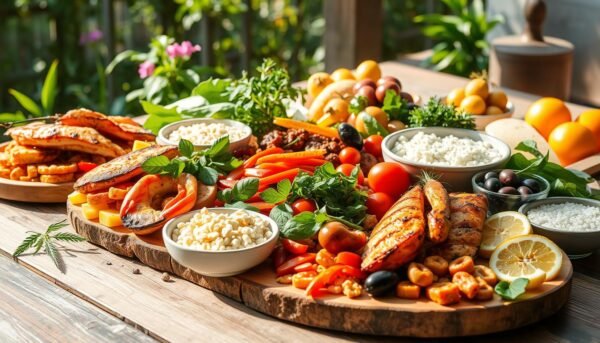
Planning meals is key to success on the Mediterranean diet. Start by prepping meals at the beginning of the week. This way, you can avoid stress. Make dishes like Cinnamon Roll Overnight Oats for breakfast and Vegan Superfood Grain Bowls for lunch to have ready for weekdays.
Prepare homemade dressings like Garlic-Dijon Vinaigrette to use throughout the week. Sheet-pan dinners are great for quick and easy weeknight meals. Make sure to balance your meals with vegetables, whole grains, and lean proteins.
The provided Mediterranean diet meal plan is for three calorie levels: 1,200, 1,500, and 2,000 calories per day. Each day’s meal plan has a different calorie count. For example, Day 1 has 1,223 calories, and Day 7 has 1,219 calories.
The meal plan includes a variety of foods. You’ll find fruits, dairy, proteins, vegetables, and whole grains. The sodium content varies from 1,059 mg to 1,927 mg per day.
This meal plan focuses on meal prep and using leftovers. It also suggests preparing some components ahead of time. By following this guide, you can enjoy delicious, balanced meals and get the health benefits of the Mediterranean diet.
| Day | Calories | Macronutrient Distribution |
|---|---|---|
| 1 | 1,223 | Protein: 20%, Carbs: 50%, Fat: 30% |
| 2 | 1,235 | Protein: 22%, Carbs: 48%, Fat: 30% |
| 3 | 1,205 | Protein: 21%, Carbs: 49%, Fat: 30% |
| 4 | 1,230 | Protein: 21%, Carbs: 49%, Fat: 30% |
| 5 | 1,209 | Protein: 22%, Carbs: 48%, Fat: 30% |
| 6 | 1,172 | Protein: 20%, Carbs: 50%, Fat: 30% |
| 7 | 1,219 | Protein: 21%, Carbs: 49%, Fat: 30% |
Mediterranean Breakfast Ideas and Recipes
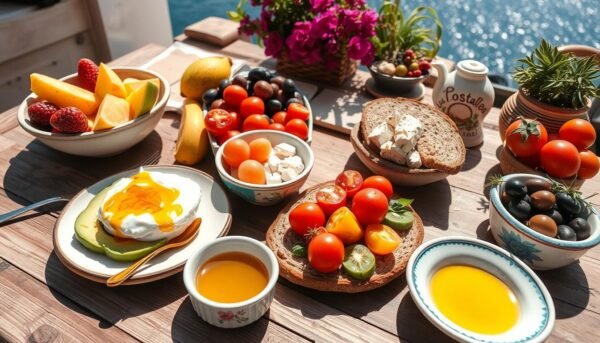
Start your day with a Mediterranean-inspired breakfast. These meals are not only tasty but also healthy. They give you energy and focus for the day.
Quick Morning Meals
For quick breakfasts, try Greek yogurt with fresh berries and crunchy nuts. Or, have whole-grain toast with avocado and tomato. A smoothie bowl with spinach, banana, nut butter, and chia seeds is also great.
Make-Ahead Breakfast Options
For a bigger breakfast, make a Mediterranean frittata with vegetables, feta, and herbs. Or, prepare overnight oats with Greek yogurt, berries, and nuts. Shakshuka with eggs in tomato sauce and whole-grain bread or pita is another good choice.
Adding Mediterranean breakfasts to your day is good for you. They give you the nutrients you need to start strong. Choose whole foods for the best results.
Lunch and Dinner Meal Combinations
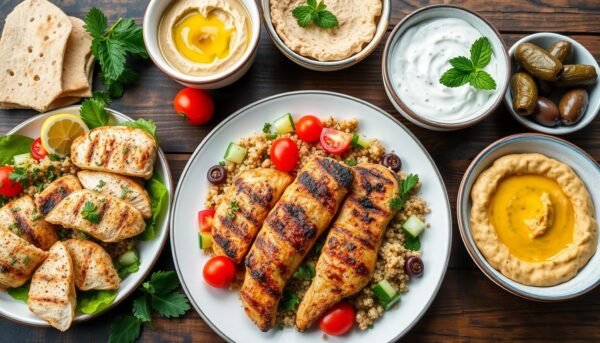
Embracing the Mediterranean diet for lunch and dinner is all about balance. You’ll enjoy lean proteins, colorful veggies, and whole grains. From seafood salads to vegetable bowls, there’s so much to try.
For a quick lunch, try a salmon salad tartine. It’s a sandwich with salmon, whole-grain bread, greens, tomatoes, and a tangy dressing. Another great choice is a Greek salad wrap. It has lettuce, feta, olives, and vinaigrette in a whole-wheat tortilla.
Dinner can be just as exciting with seafood. An air fryer salmon with Swiss chard is a tasty and easy option. The fish and greens make a perfect pair. For a veggie-packed dinner, try creamy kale pasta with beans or tofu. It’s full of plant-based protein.
| Lunch | Dinner |
|---|---|
| Salmon Salad Tartine | Air Fryer Salmon with Swiss Chard |
| Greek Salad Wrap | Creamy Kale Pasta with Added Protein |
The secret to great Mediterranean meals is a balanced plate. Half should be veggies, a quarter whole grains, and the last quarter protein. This way, you get great taste and lots of nutrients.
Smart Snacking on the Mediterranean Diet
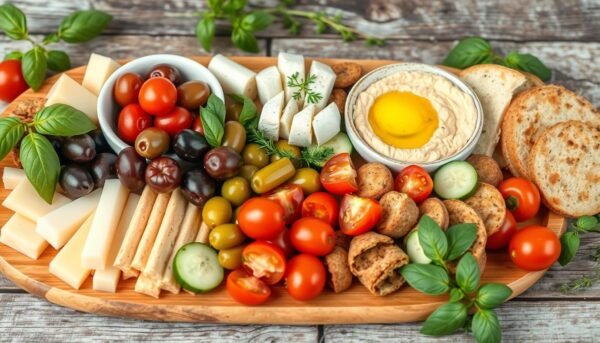
Snacking on the Mediterranean diet should focus on nutrient-dense foods. These foods should complement your overall eating plan. By pairing the right combinations of healthy fats, proteins, and carbohydrates, you can create satisfying snacks. These snacks will help you until your next meal without derailing your progress.
Healthy Snack Pairings
Some delicious and nutritious Mediterranean diet snack pairings include:
- Fresh vegetables like carrots, bell peppers, or cucumbers with homemade hummus or tzatziki (cucumber yogurt dip)
- A handful of unsalted nuts, such as almonds or walnuts, with a fresh fruit like an apple or grapes
- Greek yogurt with a drizzle of honey and chopped nuts
Portion Control Guidelines
When it comes to snacking on the Mediterranean diet, portion control is key. Stick to about 1/4 cup of nuts, 1 cup of fresh fruit, or 1/2 cup of Greek yogurt per serving. Remember, snacks should complement your meals, not replace them. They help prevent overeating at main meals.
By incorporating these healthy, satisfying snack options into your Mediterranean diet, you can curb hunger. You can also boost your nutrient intake and stay on track toward your health and wellness goals.
Incorporating Fresh Produce and Seafood
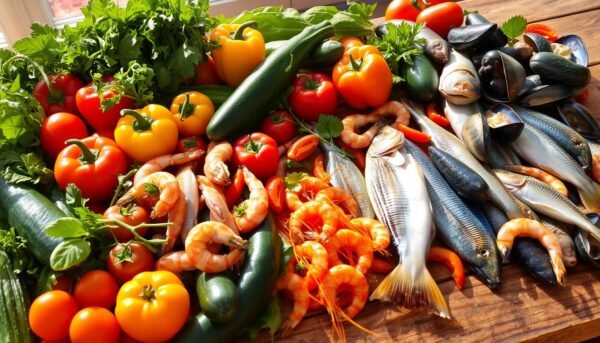
The Mediterranean diet focuses on fresh vegetables and fruits. These foods are full of important nutrients. Try to eat at least 3 servings of veggies and 3 servings of fruit every day.
Choose locally grown, in-season produce for the best taste and nutrition.
Seafood, especially fatty fish with omega-3 fatty acids, is key in this diet. Aim for 3 seafood meals a week. Salmon, sardines, mackerel, and anchovies are great choices. They’re good for your heart and can lower heart disease risk.
- Enjoy a variety of colorful, seasonal vegetables to ensure a diverse array of vitamins, minerals, and antioxidants.
- Incorporate fruits as natural, nutrient-dense snacks and desserts.
- Prioritize fatty fish high in omega-3s, such as salmon, sardines, and mackerel, for their anti-inflammatory properties.
- Explore other seafood options like shrimp, mussels, and clams for their lean protein and essential nutrients.
By embracing fresh produce and seafood from the Mediterranean, you start a tasty and healthy journey. It’s a path to better health and happiness.
Role of Healthy Fats and Olive Oil

Healthy fats, especially extra virgin olive oil (EVOO), are key in the Mediterranean diet. EVOO is full of monounsaturated fats and antioxidants. It’s a main part of this healthy eating plan. Other good fats come from nuts, avocados, and fatty fish with lots of omega-3 fatty acids.
Types of Beneficial Fats
The Mediterranean diet focuses on healthy fats from different sources:
- Monounsaturated fats: Found in EVOO, avocados, and some nuts, these fats lower bad cholesterol and help the heart.
- Polyunsaturated fats: Omega-3 and omega-6 fatty acids in fish, flaxseeds, and some oils are good for the brain, reduce inflammation, and keep the heart healthy.
- Saturated fats: These should be eaten in small amounts because they can raise bad cholesterol and increase heart disease risk.
- Trans fats: Made artificially, these bad fats should be avoided. They can raise bad cholesterol, lower good cholesterol, and greatly increase heart disease risk.
Daily Fat Intake Guidelines
In the Mediterranean diet, healthy fats make up about 30% of daily calories. Try for 1-4 tablespoons of EVOO each day instead of other fats for cooking and dressing. Also, eat at least 3 servings of nuts per week, like almonds, walnuts, and chia seeds. They add more heart-healthy fats and nutrients.
By focusing on these healthy fats, you can get many benefits from the Mediterranean diet. These include less inflammation, better heart health, and better nutrient absorption.
Mediterranean Diet Serving Sizes and Portions
Keeping portion sizes right is key in the Mediterranean diet. It’s all about balanced meals and following nutritional guidelines. This helps you stay healthy.
Fruits and veggies should be at least 3 servings a day. A serving is 1/2 to 1 cup. Whole grains are important too, aiming for 3 to 6 servings a day. A serving is 1/2 cup cooked or 1 slice of bread.
Protein is important, but limit poultry and dairy to once a day. A 3-ounce portion is good for poultry. Red meat should be eaten no more than once a week. Aim for a balanced plate with half veggies, a quarter whole grains, and a quarter lean protein.
| Food Group | Servings per Day | Serving Size |
|---|---|---|
| Fruits | 3 or more | 1/2 to 1 cup |
| Vegetables | 3 or more | 1/2 to 1 cup |
| Whole Grains | 3 to 6 | 1/2 cup cooked or 1 slice of bread |
| Poultry | 1 to 2 | 3 ounces |
| Dairy | 1 to 3 | 1 cup |
| Red Meat | Limited to 1 time per week or less | 3 ounces |
By sticking to these portion guidelines, you can enjoy the Mediterranean diet’s health benefits. Make sure to eat a variety of fresh, seasonal foods and lean proteins. This way, you’ll have tasty and healthy meals.
Tips for Long-Term Mediterranean Diet Success
To succeed on the Mediterranean diet, focus on lasting lifestyle changes. Plan your meals ahead and cook at home. This way, you control what you eat and stick to the diet’s principles.
Enjoy meals with family and friends. Eating together makes the diet more enjoyable. Also, add physical activity to your life. Aim for 150 minutes of moderate exercise each week.
The Mediterranean diet is more than food. It’s about enjoying meals, staying active, and managing stress. Drink plenty of water and find ways to relax. These changes will help you succeed in the long run.
This post may contain affiliate links which means I may receive a commission for purchases made through links. I will only recommend products that I have personally used! Learn more on my Private Policy page.